Top 9 Skirt Steak Substitutes
When you buy through our links, The Breslin may earn an affiliate commission. Learn more
These skirt steak substitutes are perfect for recreating those steakhouse-style recipes. Whether you’re fed up with skirt steaks or attempting an extra-special meal, finding an excellent skirt steak alternative can be your game-changer.
These steaks are mostly available in grocery stores and meat markets. But for fewer available cuts, you might have to call your butcher in advance to order. Or else, if you’re halfway through cooking, use the best cut that you’ve got in your fridge.
Not panic – that’s what! I’ve scoured the meat market to give you the most comprehensive list of skirt steak stand-ins. You’ll discover their distinctive flavors, textures, and some best-kept butcher secrets to nail them for dinner.
If you’re ready to put something oh-so-good on the table, let the discovery begin!
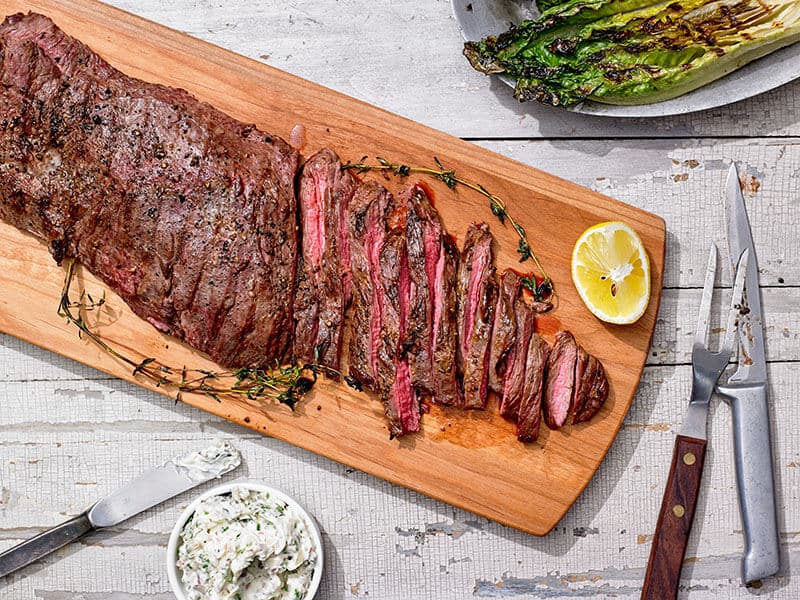
The Ultimate Guide To Skirt Steak
Often an unsung cut, skirt steak is the best bang for your buck. Stick around for more interesting facts on this flavorful cut of beef for your recipes.
What Is A Skirt Steak?
In short, skirt steak is a long and thin cut of beef that comes from the diaphragm muscles or the plate primal area sitting below the ribs of the steer. This part tends to be lean and contains more tough fibers than other flat steaks.
Length-wise, a skirt steak is usually somewhere between 20 and 24 inches and about 3 to 4 inches wide. The steak has thick grains running across its length.
There’re two types of skirt steaks: the inside and outside, each with a different texture and tenderness. More often than not, outside skirts end up in commercial restaurants. So chances are, the cut you encounter at a meat market is the inside skirt.
- The outside skirt steak: Tender, thick, and more uniformed with good marbling, the steak is more desirable. Plus, it’s often longer compared to the inner cut.
- The inside skirt steak: At about five to seven inches, the inside skirt is wider yet only half as thick. Hence, it’s likely chewier, coarser, and even shrinks a little as it cooks up.
Flavor And Texture
As for the taste, a skirt steak has a reputation for its intensely beefy and buttery flavor, which sometimes resembles livers. No matter if you’ve got the inner or outer cut, it’s going to have a few buttery swaths of fat, meaning good juiciness and tastiness when done right.
With distinctive marbling and open grain, the cut takes on flavors well when marinated, which helps to enhance and tenderize it. That also means the steak should be cut or thinly sliced against the grain for serving.
Skirt Steak’s Nutritional Values
It’s easy to get a grip of the skirt steak’s nutritional values if you buy it from the grocery store. But whether it’s from the butcher or a restaurant, these pieces of information will help you get a general idea of what’s on your plate.
On a side note, the nutritional facts for four ounces of raw steak equal 3 ounces of cooked steak. The difference is merely due to the loss of water weight as the meat cooks. Other than that, nothing else changes!
| Nutrition (Serving size: 4oz raw) | Value |
| Calories | 230 |
| Total Fat | 15g |
| Saturated fat | 6g |
| Cholesterol | 70mg |
| Sodium | 75mg |
| Protein | 23g |
Choosing The Best Skirt Steak Substitute For Your Recipes
It’s good to know some great alternatives for skirt steak when buying meat that’s equally tasty and affordable. Let’s find out what makes these cuts of beef suitable for your recipe and how to cook them properly.
1. Flank Steak
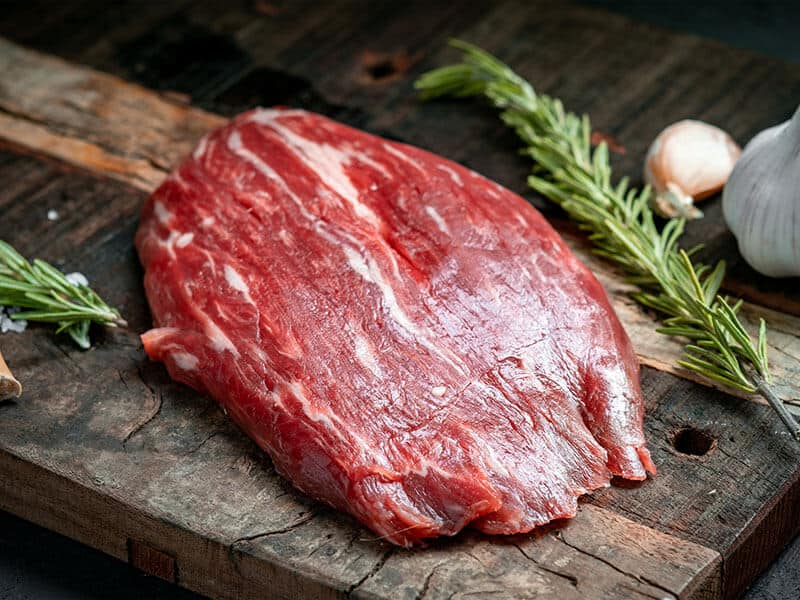
Another lesser-known yet incredibly flavorful cut, flank steak, shares many similarities with skirt steak. In the world of smoking and grilling, these two are used interchangeably in many recipes for good reasons.
First thing first, flank steak comes from the cow’s abdominal muscles or lower chest, which handles tons of workload in the animal’s life. It’s typically one-foot inch thick, one-foot long, and cooked as a whole cut rather than divided.
As with its skirt counterpart, flank steak is also relatively lean, tough, and has a strong beefy taste. It responds well to marinade and becomes super tender upon cooking.
The best way to properly cook this cut is to sear it with high heat so that the outer layer gets nice and crispy while the inside remains medium-rare to medium.
However, it’s safe to say that flank steak has lower fat content than its counterpart. While cooking, the fat is supposed to warm up and tenderize the meat, resulting in juicy results. With its lack of fat, flank can be a bit harder to work with.
With its texture, flank steak should be served medium, medium-rare, or rare. Cook it too long, and you end up with a rubbery, dry, and chewy mess, which is a nightmare for any steak geek.
On a price basis, flank steak is extremely affordable without sacrificing the flavors. So if you’re pinching pennies, it’s the perfect alternative to put an easy yet fancy dinner on the table.
You can use flank steak for any application you would skirt steak. It’s an excellent choice for stir-fries, fajitas, tacos, and grain bowls. I also recommend this stand-in for grilling and slow-cooked recipes such as goulash soups and stews.
Marinating and grilling flank steak is a cinch with this chef guide!
2. Flap Steak
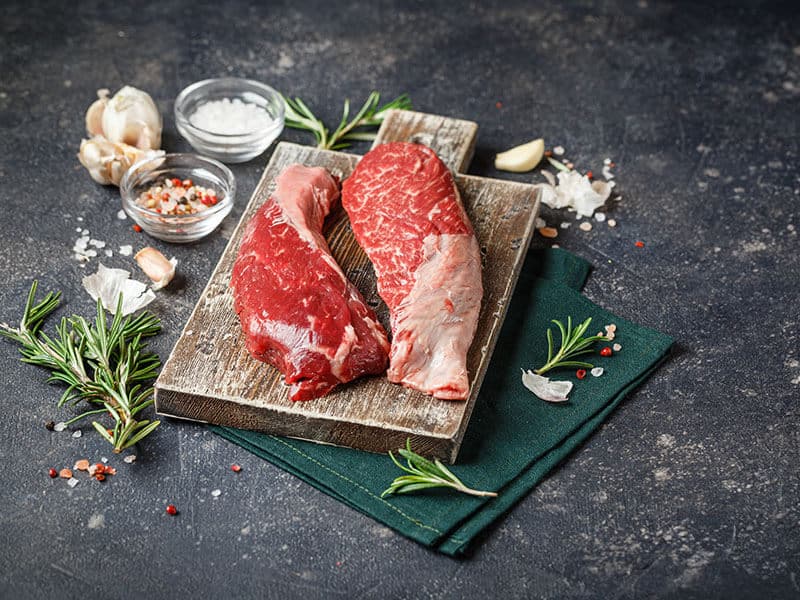
Of all the budget-friendly cuts of beef, flap steak is considered one of the most versatile. In many regions, you may also encounter flap steak going by its French name, bavette, flap meat, or sirloin tip.
Essentially, it’s a thin, lean, and coarse-grained cut taken from the cow’s bottom sirloin, which is the same area that the popular tri-tip comes from.
In contrast to its affordable price, this underdog from the beef world is known for its wonderful beefy, rich flavor in its own right. The texture is somewhat perfectly balanced between lean and fatty meat.
Similar to the skirt, flap meat benefits from marinating. It’s really at its best when cooked by a dry heat method such as pan-searing, broiling, and grilling, as long as the heat is high.
After cooking, I recommend letting the meat rest for 10 minutes for best results. Then, the trick to making this cut easier to chew is to slice it across the grain thinly.
On the downside, flap steak tends to lack the skirt’s tenderness and prominent flavor. But you can make the best out of it by soaking it in the right ingredients and cooking it properly when there’s no skirt steak on hand.
3. Ribeye Steak
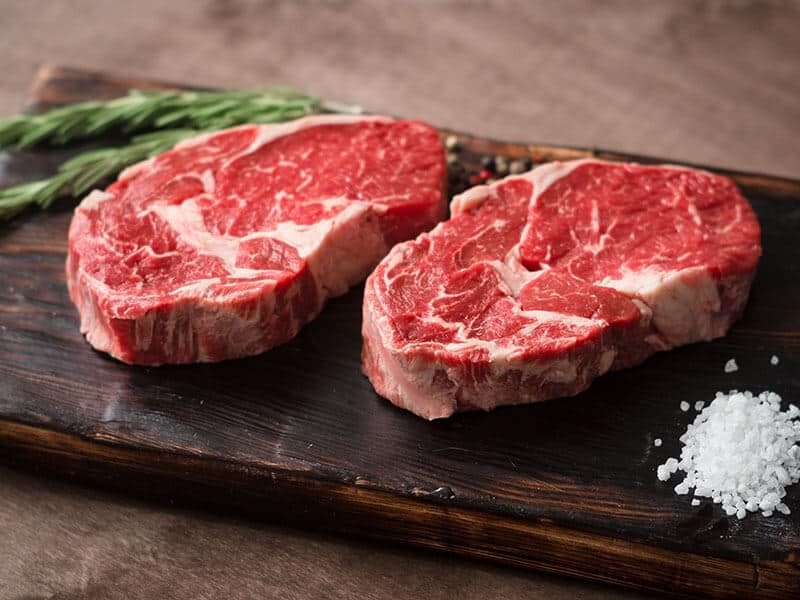
Fingers crossed, ribeye steak claims its throne as the epitome of steak flavor to most steak lovers worldwide. Take a trip to the meat shop, butcher, or any grocery store, and it’s impossible not to come across this popular cut.
Texture-wise, ribeye has incredible fat marbling, which explains why it’s such a juicy, tender, and chock full of flavors part in the beef. As its name implies, the cut comes from the rib portion of a cow.
As far as flavor is concerned, ribeye delivers in every bite. It offers a strong yet well-balanced taste that’s so moist, rich, and satisfying when properly cooked. Each bite tastes like a heavenly balance of creaminess and rich beefy flavor.
An all-rounder cut, ribeye works well in any recipe that incorporates skirt. For such a marbled cut, rib eye is best served medium-rare or medium. Whether you pan-sear it on a hot skillet or on the grill, it’ll leave you drooling in minutes.
More often than not, you don’t have to do anything other than add a pinch of salt and pepper before you cook it. A quick turn on the grill is all you need. And you can always pair it with mouth-watering BBQ side dishes to round out your summer cookout.
If you’re inexperienced with cooking ribeye, keep in mind that the steak is prone to flaring up due to its high-fat content. (1) Thus, it’s important to keep an eye on it during the cooking process.
Compared to skirt steak, ribeye is undoubtedly more expensive. It owns a special place in most high-end steakhouses and restaurants. This way, you should take their price difference into consideration when planning to switch to ribeye for your meals.
This is how the world-famous chef Gordon Ramsay cooks his ribeye steak!
4. Beef Tenderloin
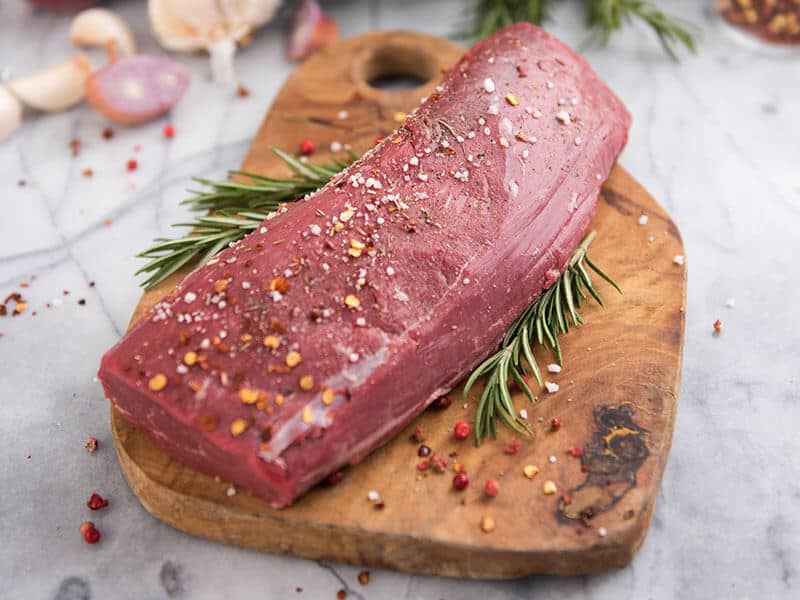
Another fancy cut of beef that steak enthusiasts can’t get enough of is that beef tenderloin widely prized as the most tender steak. It also goes by different names such as filet mignon, eye fillet, and fillet around the world.
Tenderloin refers to the long, thin muscle located within the loin. This cut is so soft, rich, and retains its tenderness when cooked, which is why many steak lovers are willing to pay top dollar for it.
That being said, tenderloin isn’t at all without its problems. On its own, the steak isn’t very flavorful. Therefore, it’s usually paired with gravy or some bacon for extra dimensions of flavors.
A well-kept secret to nailing this steak is to cover its surface with a thin layer of salt, herbs, and crushed garlic. When cooking, the lack of fat means that the meat cooks up much faster than the skirt and is more susceptible to drying out.
Good steaks always start with good seasoning. Tenderloin can be taken to a new level with a good spice rub that adds loads of flavors to it. As told from the name, the cut works well in recipes that require tender meat such as braises and casseroles.
Generally speaking, tenderloin has to be one of the most expensive steaks around. If you’re looking for a fancy skirt steak stand-in that can take center stage at a holiday feast or a romantic meal for two, this should be it.
5. Hanger Steak
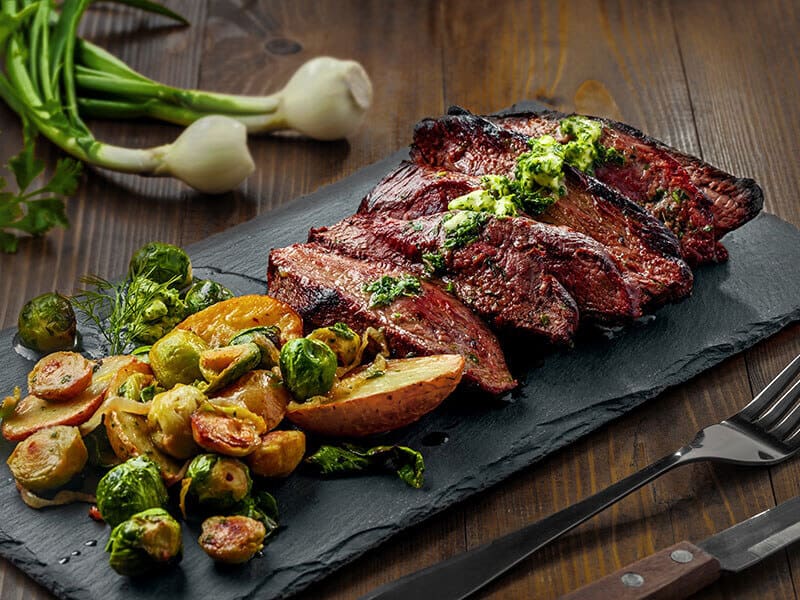
Some folks may say that hanger steak is a wonderful marriage between ribeye and tenderloin. And they’re not wrong! Hanger steak combines that juicy, melt-in-your-mouth tenderness with a rich, beefy flavor that makes every bite a pleasure.
In fact, butchers used to keep this meat for themselves for its rich flavor, hence its other name, butcher steak. Similar to skirt steak, the hanger is taken from the cow’s diaphragm or plate.
In terms of texture, hanger steak shares many things in common with its skirt counterpart. It’s grainy and super tender with a good amount of marbling.
Hanger steak is a heavenly cut for meat-eaters who love an intensely beefy flavor. Although a thin cut, it’s rich, robust, and often with a hint of iron flavor that makes each bite even more hearty and full.
Whether a seasoned cook or a novice in the kitchen, cooking the perfect hanger steak is a breeze. All it really needs is a blanket of salt and pepper, but the cut also stands up well to strong marinade. Then, dry meat and high heat are the two secrets to success.
Typically, pan-searing and grilling are two ways to get the best out of hanger steak. Since the cut is pretty thin, you should keep a good eye on it not to overcook. Otherwise, it’ll become chewy and tough.
The truth is, each steer only provides two hanger steaks. Therefore, it’s much less available compared to other cuts. If you happen to have a cut on hand, it’s a great alternative for the skirt in most recipes.
Everything a steak lover need to know about the underrated hanger steak.
6. Strip Loin Steak
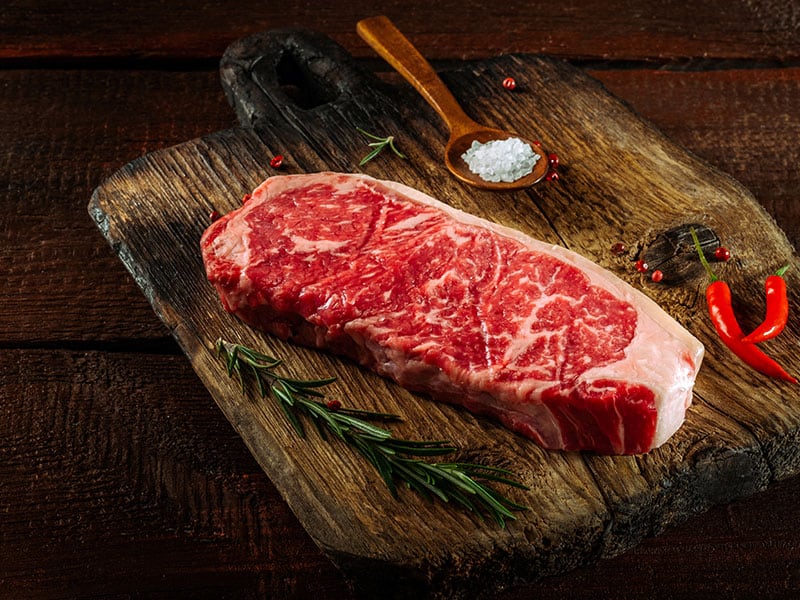
Strip loin steak, or strip steak, is a tender cut from the short loin of the cows. This particular area is not in heavy use throughout the cow’s life, making it super tender. Compared to the skirt, it’s typically on the thicker side.
When preparing an easy, quick steak dinner that doesn’t skimp on the flavors, the strip steak is your go-to. It’s mouth-watering, easy to cook, and perfect for small portions.
Practically speaking, strip loin is a moderately expensive cut, although more accessible than a few others. In fact, it’s one of the most famous cuts at top-notch steakhouses across the country.
Butchers will often offer you boneless strip loin, but there’s always an option to leave the bone in. The boneless version acts a lot more similar to skirt steak when cooking.
On the other hand, a bone-in cut does more than just for show. It allows the steak to retain its juiciness and moisture while cooking. But there’s a catch! Nailing the perfect bone-in strip loin requires more culinary skills and experience.
From fajitas to wraps and steak salads, strip loin steak is sure to satisfy even the fussiest eaters around. You can also toss a few bits on top of noodles and pasta, or pair them with a side of mashed potatoes for a well-rounded meal.
For parties and outdoor activities, grilling thesteak on a super-hot grill gives it desirable sear and flavor for serving with other delicious picnic side dishes. Meanwhile, you can pan-roast or reverse-sear it for a classic weeknight dinner.
7. Flat Iron Steak
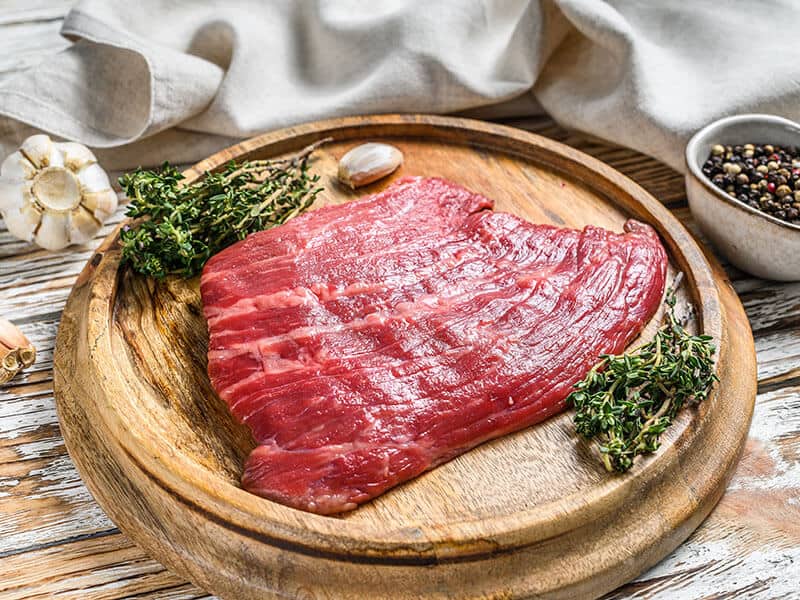
A steak that’s growing in popularity, flat iron steak is renowned as the second-most tender cut out there, only after the famous filet mignon. It has the quality of an expensive cut minus the over-the-top price.
Technically, flat iron steak is cut from the cow’s shoulder, and more specifically, the top blade. You’re looking at a decent-exercised steak that has just enough marbling for a rich, ultra-juicy flavor.
One of those things that I love most about this steak is how it absorbs flavors from different cooking methods. With just a simple seasoning of cracked pepper and salt, it takes the limelight. But you can always experiment with tons of spice rubs that fit your palate.
The deep, rich flavor doesn’t only shine through on its own; flat iron also goes well in various dishes such as sandwiches and side dishes of tacos for your taco night. For slow-cooked courses such as casseroles and stews, the steak is best cut into thin slices.
It’s safe to say that this cut tends to be thicker and more marbled than its skirt counterpart. Therefore, keep in mind that when you use flat iron steak in place of the skirt, it’s important to sear it on high heat before heating it in a lower temperature setting.
Whip up the perfect flat iron steak that melts in your mouth! You can see this video to know more:
8. Sirloin Tip Side Steak
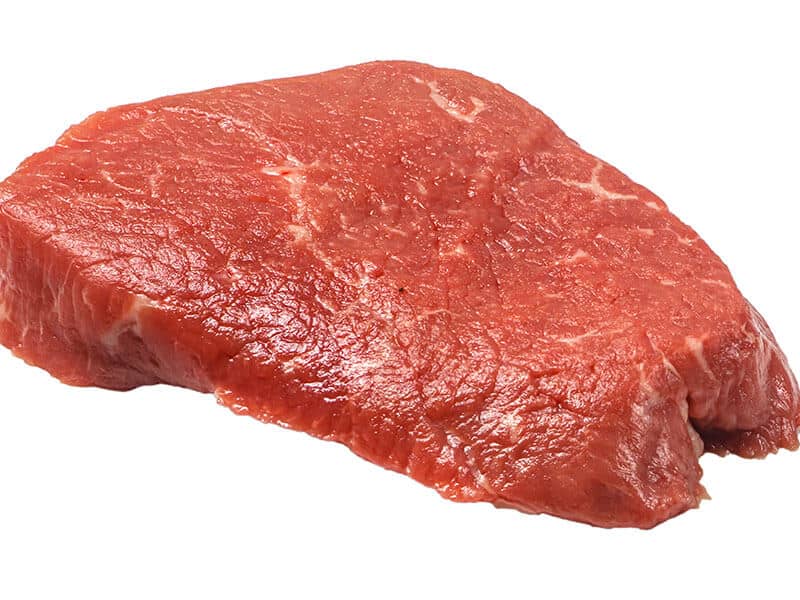
The name of sirloin tip side steak gives a clue about where it’s from. The steak is cut from the cow’s rear muscle, also known as the round. As one of the muscles a cow uses to walk, this cut isn’t quite as tender as some of the other steaks you can buy.
Boneless and lean, the sirloin tip side tastes best with a tenderizing marinade prior to cooking. Plus, any extra fat is usually trimmed before being sold by the butcher or retailer, hence its distinctive leanness and low-fat level.
This tip side steak fits a lot of applications such as for cube steaks, stir-fries, or stews, basically anything you would skirt steak. For maximum flavors, braising, stewing, and broiling are the best methods to help tenderize the meat.
When it comes to cooking sirloin tip side steak, an important thing to keep in mind is how susceptible it is to overcook. You should use a marinade, wine, or sauces to marinate it for several hours before cooking and keep a good eye on it while it’s on the grill.
9. Short Loin Steak
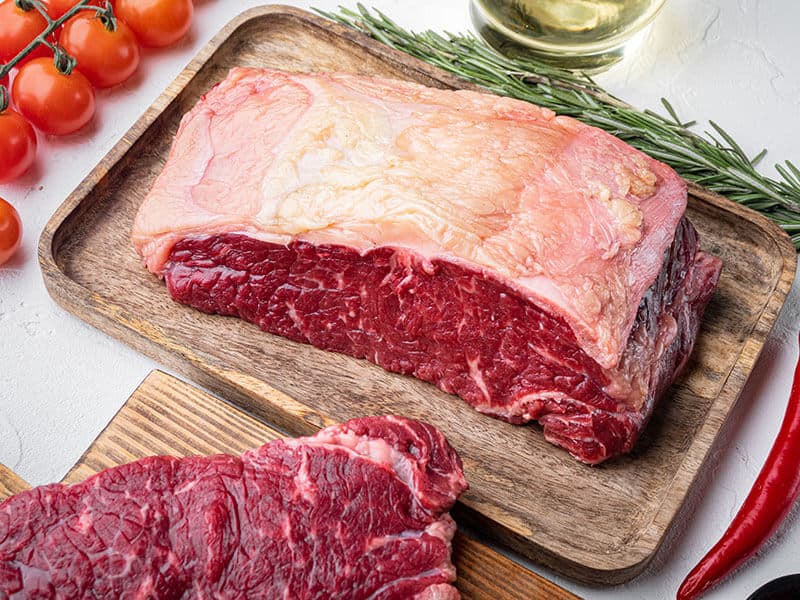
Perhaps one of the most sought-after sections, short loin is home to some extremely tender cuts. The top section yields porterhouse and T-bone steaks.
Leave the bone in and you have yourself the T-bone. Meanwhile, removing the bone gives a New York Strip steak and a tail half of the tenderloin.
When it comes to beef steak, the further it locates from the hoof or the horn, the more tender it typically is. Coming from the back of a steer, the muscles in these areas don’t have much work to do, which gives them tenderness with a decent beefy flavor.
Bone-in short loin is absolutely the best! While the meat itself is juicy and full of fat, a bone adds moisture and flavors to it during the cooking process. It also radiates the heat and continues cooking the meat even after being taken off the pan.
Cooking this cut is similar to skirt steak, but triple the cooking time and double the resting time afterward to at least 10 minutes. Ideally, you’ll want a nice crust on the outside without overcooking the inside of the steak.
These loin cuts taste wonderful when cooked on a grill or under a broiler. You can use them for a diversity of recipes. Whether for the classic stir-fry or with a savory marinade, short loin is a perfect stand-in for skirt steak!
Satisfy Your Steak Cravings With These Delectable Skirt Steak Recipes
There’s no need to go to a fancy steakhouse for a fancy steak dinner. With these skirt steak recipes on hand, you can always treat yourself and your loved ones to a drool-worthy meal without burning a hole in your pocket.
1. Grilled Skirt Steak
Fast and hot cooking is a rule of thumb when it comes to nailing a skirt steak, which makes it ideal for the grill. A quick, dry spice rub is enough to elevate its flavor. Other than that, let the meaty, rich taste itself take center stage.
Typically, it only needs a few minutes on each side to create that caramelized exterior while remaining moist and tender in the center. I highly recommend accompanying it with a simple side of baked potatoes or chimichurri sauce for a well-rounded, classic dinner.
2. Korean-Style Grilled Skirt Steak
The good thing about this recipe is how simple it is to prepare, yet you can get maximum flavors even when you’re pressed on prep time. Marinating the meat with honey, soy sauce, salt, and rice vinegar not only results in flavors but also tenderizes the meat as it sits.
It’s great alongside some stir-fried veggies and tasty brown rice, especially when you let the leftover marinade simmer to turn it into a delightful sauce. Soon enough, you’ll probably be making this Korean-style skirt steak on constant repeat.
An easy tutorial for folks attempting this recipe for the first time!
3. Bourbon-Glazed Skirt Steak
This bourbon-glazed steak recipe relies on a savory, exquisite bourbon glaze and the rich, buttery flavor of skirt steak. It takes a short list of ingredients and about 40 minutes of cooking time to yield the most out-of-this-world taste.
What’s the better way to celebrate a birthday, a romantic treat for two, or a simple yet delicious family dinner with this easy and fancy dish? After cooking, allow the steak to rest for about 10 minutes before topping it with a drizzle of sauce to serve.
4. Arrachera (Skirt Steak Taco Filling)
Let’s be real. Who doesn’t have a thing for tacos? An important note when cooking this dish is to make sure to dry off the meat from the marinade before putting it on the skillet or grill to avoid steaming the steak.
A golden trick for assembling tacos with this filling is to keep things simple. Toss in the sliced steak, some white pepper, and sazon seasonings on the tacos. And there you have it, the tastiest homemade tacos ever!
5. Fajita Skirt Steak
Nothing screams family favorite like some good old skirt steak fajitas. Give the steak a quick cook with onions, bell peppers, and seasonings, and you’re off to one of the most mouth-watering recipes you’ve had.
This fajita pairs beautifully with cotija cheese and guacamole, creating that harmony of sweet, spicy, and savory flavor. When Cinco de Mayo is around the corner, it’s something that you can make in bulk and ensure success every time.
Frequently Asked Questions
If you’re still not entirely sure of what to get in place of skirt steak, these fast facts regarding the cut and its stand-ins will help you a bit more along the way.
Make Steakhouse-Style Steak Dinner Right At Home!
Fingers crossed, you can’t go wrong, but you can go extra with some skirt steaks. But when you love this cut so much, to the point that you’ve completely run out of it, these skirt steak replacements indeed come in handy.
Most of these cuts can perfectly imitate the flavors and texture of the skirt in your recipe or even better. If you’re cooking a delectable meal on a budget, flap steak is certainly your go-to.
On the other hand, filet mignon, ribeye, and tenderloin are timeless steaks for a fancy, restaurant-quality dinner that’s meant to impress.
Grab your apron, switch on the grill, and get ready to create a steak recipe that’s going to make your dinner companion swoon. And don’t forget to tell me all about your favorite skirt steak substitute!
References
1. Food Struct.. Rib eye steak nutrition, glycemic index, calories, net carbs & more. [online] Available at: <https://foodstruct.com/food/rib-eye-steak>
2. Verywell Fit.. Steak Nutrition Facts and Health Benefits. [online] Available at: <https://www.verywellfit.com/the-best-ways-to-eat-steak-on-a-diet-3495219>

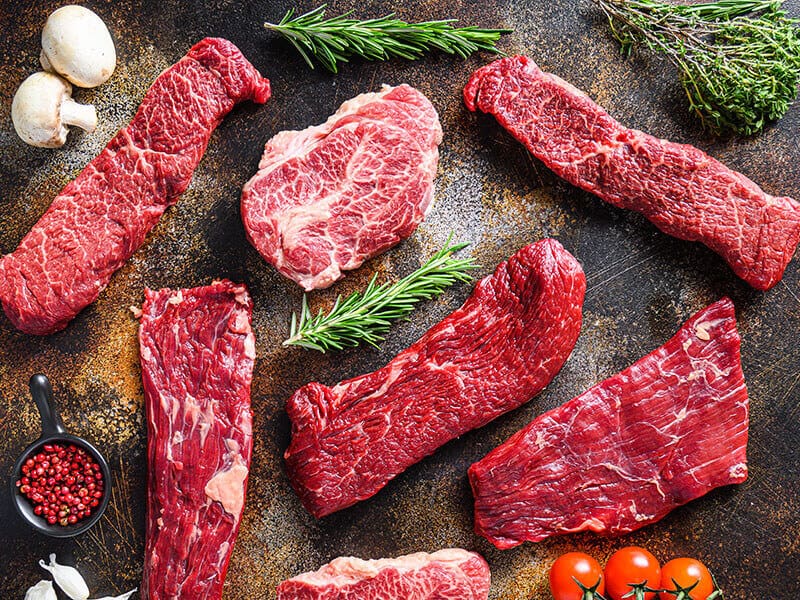

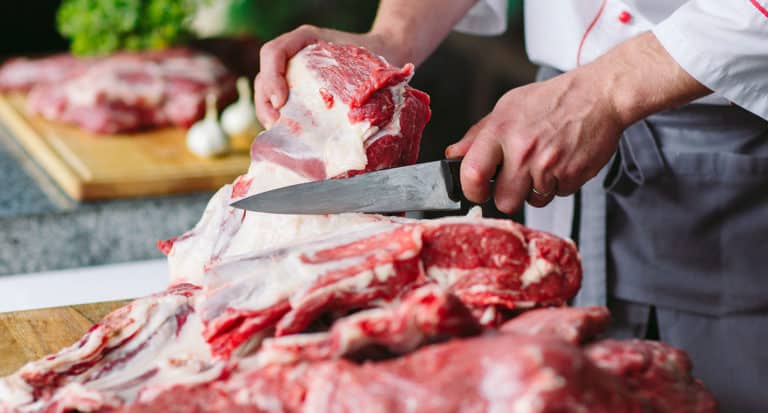
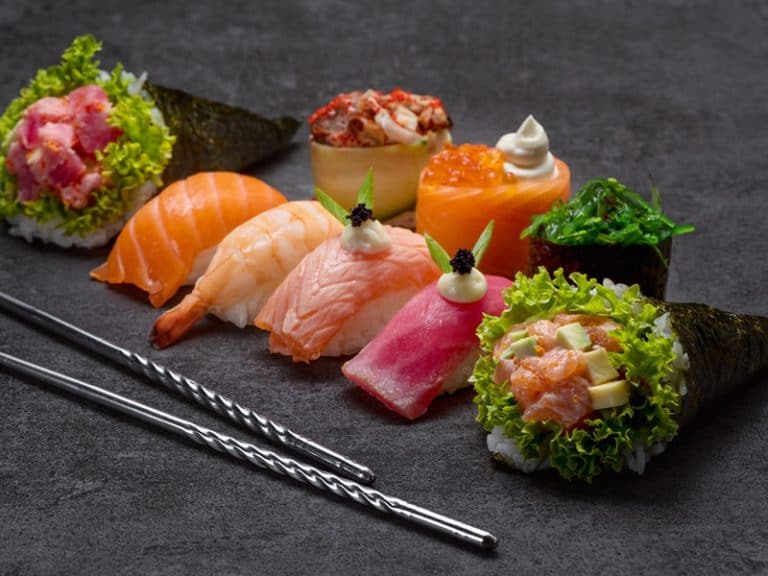

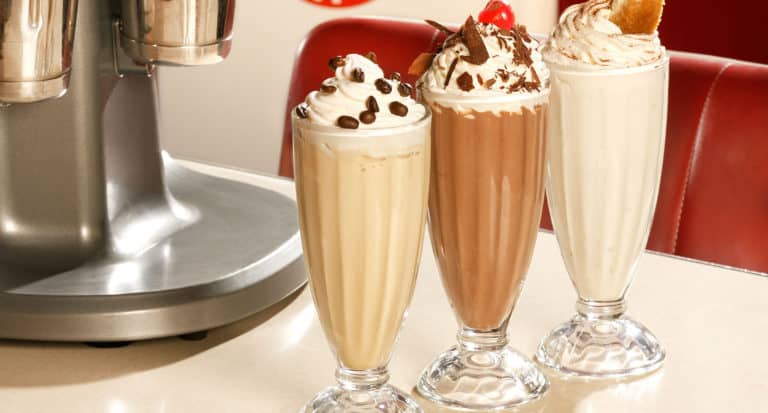

Amanda Collins
Founder and Senior Culinary Editor
Expertise
Culinary Arts and Management, Food Journalism and Critique, Recipe Development and Testing, Global Culinary Traditions, Sustainable Food Practices
Education
Institute of Culinary Education (ICE), New York, NY
Program: Diploma in Culinary Arts
Focus: Intensive hands-on training in culinary techniques, recipe development, and kitchen management, preparing students for professional roles in the culinary industry.
Monroe College, New Rochelle, NY
Program: Associate in Applied Science in Culinary Arts
Focus: Practical culinary skills, including cooking techniques, menu planning, and kitchen operations, with an emphasis on hands-on experience and industry standards.
Amanda Collins is a seasoned chef and food editor with a deep love for global flavors. Trained at the Institute of Culinary Education and Monroe College, and with over 15 years in the culinary field, Amanda has refined her skills in kitchens worldwide. Her background in food studies gives her a unique ability to share both recipes and the cultural stories that shape them.
As senior culinary editor at thebreslin.com, Amanda’s work brings authentic dishes to life, inviting readers to explore new flavors and techniques from around the globe. Her approachable style makes it easy for anyone to bring a bit of the world’s cuisine into their kitchen.